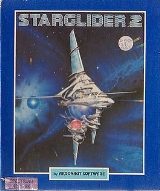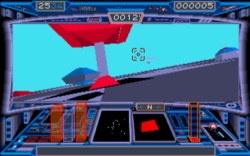
Starglider 2
Encyclopedia
Starglider 2 was an early 3D
space simulator
/flight simulator
video game released in 1988 by Argonaut Games
and was the sequel
to Starglider
. It was released for the Amiga
, Atari ST
, DOS
, Apple Macintosh and ZX Spectrum
home computer
s.
al graphics (only on 16 bit versions), and featured open, continuous gameplay without levels
or loading screen
s after the game had started, despite taking place across an entire planetary system. The player could fly through space, enter a planet's atmosphere, explore the surface, and penetrate subterranean tunnels in one seamless movement.
The goal of Starglider 2 was to destroy an enemy space station
with a neutron bomb
, and the majority of the gameplay consisted of collecting parts for the bomb, or fulfilling other prerequisites (e.g. finding the nuclear professor capable of constructing the bomb, or trade goods for the bombs necessary to destroy the shield generators protecting the space station), while fighting off enemy spacecraft, and delivering collected items to depots inside planetary tunnel systems. The various objects needed to complete the game were distributed across the many planets of the solar system, as well as in the intervening space (e.g. asteroids and space pirates), or even in the atmosphere of the gas giant planet.
 The flight model was arcade-style as opposed to realistic, as the game featured no inertia; the spacecraft banked like an aircraft to turn, in air, outer space, and underground; and it was possible to hover
The flight model was arcade-style as opposed to realistic, as the game featured no inertia; the spacecraft banked like an aircraft to turn, in air, outer space, and underground; and it was possible to hover
. In addition, the game featured many graphic display options, including the ability to eliminate roll
, or view the game from outside the cockpit from a non-chase-camera, making it difficult to fly but allowing the player to view the polygonal model of the spacecraft.
The construction of the shield generators and the space station itself progressed continuously over the course of the game, and failure to destroy the space station before construction was complete would result in loss of the game (the space station would be used to destroy the player's home planet). Successfully destroying the space station would not end the game, despite treating the player to a spectacular explosion and congratulatory text; instead, it would simply reset the construction of the space station, and the player could again begin attempting to gain possession of another neutron bomb with which to destroy the station.
The Atari ST and Commodore Amiga versions used Argonaut's "Argonaut Dual Loading System", a system whereby the discs were supposed to be interchangeable; the Atari ST disc could be used to load the game onto a Commodore Amiga and vice-versa. This was supposed to save money, by allowing publishers to produce a single boxed version of the game for both formats. In practice, the system was unreliable, and after Starglider 2 it was abandoned.
, certain releases of the game included a production made with professional synthesizers of Dave Lowe's instrumental theme on a separate cassette tape.
praised the game for being a vast improvement over the original, saying the game had "no real weak points". Minor criticisms were levelled at the game's joystick controls (preferring to control the game with a mouse) and at the game's philosophy of leaving players no clue as to how to succeed.
3D computer graphics
3D computer graphics are graphics that use a three-dimensional representation of geometric data that is stored in the computer for the purposes of performing calculations and rendering 2D images...
space simulator
Space simulation
A space simulator is a system that tries to replicate or simulate outer space and/or the experience of space flight in a spacecraft as closely and realistically as possible...
/flight simulator
Flight simulator
A flight simulator is a device that artificially re-creates aircraft flight and various aspects of the flight environment. This includes the equations that govern how aircraft fly, how they react to applications of their controls and other aircraft systems, and how they react to the external...
video game released in 1988 by Argonaut Games
Argonaut Games
Argonaut Games plc was a British video game developer. Founded as Argonaut Software by teenager Jez San in 1982 the company name is a play on his name and the movie title Jason and the Argonauts. It had its head offices in Edgware, London....
and was the sequel
Sequel
A sequel is a narrative, documental, or other work of literature, film, theatre, or music that continues the story of or expands upon issues presented in some previous work...
to Starglider
Starglider
Starglider is a 3D video game released in 1986 by Rainbird. It was developed by Argonaut Software, led by programmer Jez San. The game was inspired by Jez San's love of the 1983 Atari coin-op Star Wars, It was a fast-moving, first-person combat flight simulator, rendered with colourful wireframe...
. It was released for the Amiga
Amiga
The Amiga is a family of personal computers that was sold by Commodore in the 1980s and 1990s. The first model was launched in 1985 as a high-end home computer and became popular for its graphical, audio and multi-tasking abilities...
, Atari ST
Atari ST
The Atari ST is a home/personal computer that was released by Atari Corporation in 1985 and commercially available from that summer into the early 1990s. The "ST" officially stands for "Sixteen/Thirty-two", which referred to the Motorola 68000's 16-bit external bus and 32-bit internals...
, DOS
DOS
DOS, short for "Disk Operating System", is an acronym for several closely related operating systems that dominated the IBM PC compatible market between 1981 and 1995, or until about 2000 if one includes the partially DOS-based Microsoft Windows versions 95, 98, and Millennium Edition.Related...
, Apple Macintosh and ZX Spectrum
ZX Spectrum
The ZX Spectrum is an 8-bit personal home computer released in the United Kingdom in 1982 by Sinclair Research Ltd...
home computer
Home computer
Home computers were a class of microcomputers entering the market in 1977, and becoming increasingly common during the 1980s. They were marketed to consumers as affordable and accessible computers that, for the first time, were intended for the use of a single nontechnical user...
s.
Plot and gameplay
The game used solid shaded 3D polygonPolygon
In geometry a polygon is a flat shape consisting of straight lines that are joined to form a closed chain orcircuit.A polygon is traditionally a plane figure that is bounded by a closed path, composed of a finite sequence of straight line segments...
al graphics (only on 16 bit versions), and featured open, continuous gameplay without levels
Level (computer and video games)
A level, map, area, or world in a video game is the total space available to the player during the course of completing a discrete objective...
or loading screen
Loading screen
A loading screen is a picture shown by a computer program, often a video game, while the program is loading or initializing.-Loading times:Loading screens that disguise the length of time that a program takes to load were common when computer games were loaded from cassette tape, a process which...
s after the game had started, despite taking place across an entire planetary system. The player could fly through space, enter a planet's atmosphere, explore the surface, and penetrate subterranean tunnels in one seamless movement.
The goal of Starglider 2 was to destroy an enemy space station
Space station
A space station is a spacecraft capable of supporting a crew which is designed to remain in space for an extended period of time, and to which other spacecraft can dock. A space station is distinguished from other spacecraft used for human spaceflight by its lack of major propulsion or landing...
with a neutron bomb
Neutron bomb
A neutron bomb or enhanced radiation weapon or weapon of reinforced radiation is a type of thermonuclear weapon designed specifically to release a large portion of its energy as energetic neutron radiation rather than explosive energy...
, and the majority of the gameplay consisted of collecting parts for the bomb, or fulfilling other prerequisites (e.g. finding the nuclear professor capable of constructing the bomb, or trade goods for the bombs necessary to destroy the shield generators protecting the space station), while fighting off enemy spacecraft, and delivering collected items to depots inside planetary tunnel systems. The various objects needed to complete the game were distributed across the many planets of the solar system, as well as in the intervening space (e.g. asteroids and space pirates), or even in the atmosphere of the gas giant planet.

Levitation
Levitation is the process by which an object is suspended by a physical force against gravity, in a stable position without solid physical contact...
. In addition, the game featured many graphic display options, including the ability to eliminate roll
Flight dynamics
Flight dynamics is the science of air vehicle orientation and control in three dimensions. The three critical flight dynamics parameters are the angles of rotation in three dimensions about the vehicle's center of mass, known as pitch, roll and yaw .Aerospace engineers develop control systems for...
, or view the game from outside the cockpit from a non-chase-camera, making it difficult to fly but allowing the player to view the polygonal model of the spacecraft.
The construction of the shield generators and the space station itself progressed continuously over the course of the game, and failure to destroy the space station before construction was complete would result in loss of the game (the space station would be used to destroy the player's home planet). Successfully destroying the space station would not end the game, despite treating the player to a spectacular explosion and congratulatory text; instead, it would simply reset the construction of the space station, and the player could again begin attempting to gain possession of another neutron bomb with which to destroy the station.
Atari ST and Amiga versions
The Atari ST version was one of the few action games that could run on that machine's mono display.The Atari ST and Commodore Amiga versions used Argonaut's "Argonaut Dual Loading System", a system whereby the discs were supposed to be interchangeable; the Atari ST disc could be used to load the game onto a Commodore Amiga and vice-versa. This was supposed to save money, by allowing publishers to produce a single boxed version of the game for both formats. In practice, the system was unreliable, and after Starglider 2 it was abandoned.
Music
In common with Carrier CommandCarrier Command
Carrier Command is a landmark 1980s computer game available on Amiga, Atari ST, PC, ZX Spectrum, Apple Macintosh, Commodore 64 and Amstrad CPC computers....
, certain releases of the game included a production made with professional synthesizers of Dave Lowe's instrumental theme on a separate cassette tape.
Reception
A review in Computer Gaming WorldComputer Gaming World
Computer Gaming World was a computer game magazine founded in 1981 by Russell Sipe as a bimonthly publication. Early issues were typically 40-50 pages in length, written in a newsletter style, including submissions by game designers such as Joel Billings , Dan Bunten , and Chris Crawford...
praised the game for being a vast improvement over the original, saying the game had "no real weak points". Minor criticisms were levelled at the game's joystick controls (preferring to control the game with a mouse) and at the game's philosophy of leaving players no clue as to how to succeed.
External links
- A review of the game scanned from Zzap! magazine
- A video of Starglider 2
- Starglider 2 at The Bird Sanctuary

